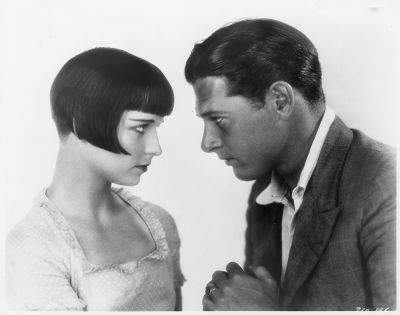
BEGGARS OF LIFE
(USA/1928) R.: William Wellman. Int.: Louise Brooks. D.: 81'. Did. inglesi
Accompagnamento al piano di Donald Sosin
Sog.: Jim Tully. Scen.: Benjamin Glazer. F.: Henry W. Gerrard. M.: Alyson Shaffer. Mus.: Karl Hajos. Int.: Wallace Beery (Oklahoma Red), Richard Arlen (il Ragazzo), Louise Brooks (la Ragazza), Robert Perry (The Arkansas Snake), Roscoe Karns (Lame Hoppy), Edgar Washington (Black Mose). Prod.: Adolph Zukor, Jesse L. Lasky per Paramount Famous Lasky Corp. 35mm. D.: 81'. Didascalie inglesi /English intertitles
Da: Georges Eastman House per concessione di Paramount Pictures
Restauro sostenuto da The Film Foundation
Dopo aver fatto esibire Richard Arlen nelle prodezze aviatorie da Oscar di Wings, Wellman immerge l'attore in uno scenario completamente diverso e gli fa interpretare un semplice Ragazzo di strada alla ricerca di cibo. Il ragazzo capita in una casa che gli sembra promettente e trova invece una Ragazza, una Louise Brooks pre-Lulu che ha appena ucciso il patrigno - l'uomo non aveva accettato un no come risposta. Vestita da uomo e con il caratteristico taglio alla maschietta, questa ragazza ben poco convenzionale decide di seguirlo: i due incartano quello che doveva essere il pranzo del morto e si incamminano verso le grandi (e meno grandi) incognite del futuro. L'apertura del film è violenta, scioccante e immediata. Come spesso accadrà nei film di Wellman, vi appaiono personaggi che non possiedono nulla e nulla hanno da perdere, i quali si incontrano per caso e decidono di mettersi in viaggio insieme nella speranza di sopravvivere e alla ricerca di un'opportunità. Naturalmente l'opportunità ha le sembianze del vagabondo per eccellenza, Oklahoma Red: il bruto dal ghigno gargantuesco interpretato da Wallace Beery non tarda a incarnare la vera anima del film, che wellmanianamente non è mai rappresentata dai giovani innamorati ma proprio dallo spietato vagabondo destinato a redimersi. Le sequenze mozzafiato sul treno, soprattutto quelle con Beery verso la fine del film, rivelano l'affinità di Wellman con la terra e con quel suolo su cui corrono le rotaie, affinità che presto sarà messa in ombra - soprattutto dopo le immagini spettacolari di Wings - da quella con l'aria e il cielo. I vagoni in corsa vibrano di vita e sprizzano scintille di velocità. Se il loro movimento rappresenta la libertà, gli spazi ristretti e bui dei loro interni la smentiscono. Con il suo aspro umorismo, la scena in cui Oklahoma incita al disordine il tribunale di miserabili convocato per decidere il destino dei due ragazzi è una tipica trovata alla Wellman, ma è anche la chiave di lettura del film e di buona parte della futura carriera del regista. Come scrive Manny Farber: "Nei film di Bill Wellman ci sono almeno quattro registi: un sentimentale, un fine pensatore, un demenziale artista di varietà e un sapiente maestro della scorciatoia con un debole per i brutti musi che si esprimono prendendo a calci in testa l'avversario o standosene cupi in disparte. Questa materia densa, volgare e di bassa lega è la specialità di Wellman, che in tali frangenti sa creare ingegnosamente e a basso costo lampi di feroce sfrontatezza, di violenza beffarda [...] e di sfrenato baccano".
Gina Telaroli
After Richard Arlen performed feats of flight for Oscar glory in Wings, Well-man thrust him into a starkly different landscape and he found himself playing a simple Boy, on the road, homeless and looking for food. His boy happens upon a house that looks promising but instead finds a Girl, a pre-Pandora's Box Louise Brooks, standing next to a man she killed moments prior, her step-father, after he wouldn't take no for an answer. Outfitted in men's clothing, with her signature bob, the not-so-girly girl decides to join the boy. They wrap up the dead man's breakfast and set off into the great (and not-so-great) unknown. For the opening of a film, it's violent, jarring, and immediate, and, as would come to be the tendency in Wellman's career, features characters with nothing to their names, especially not something to lose, who happen upon each other and decide to go forth together in hopes of survival and finding opportunity. Of course the opportunity they find is none other than the highest hobo of them all, Wallace Beery's Oklahoma Red. He starts out a brute, but eventually his gargantuan grin comes to represent the true soul of the picture, which as this is a Wellman yarn, was of course never the young lovers, but the heartless hobo who redeems himself in the end. The train sequences, particularly the ones that feature Beery and come towards the end of the picture, are breathtaking and demonstrate Wellman's connection to the ground, to the earth the railroad tracks lie on, a connection that would be overshadowed, especially after the spectacle of Wings, by his association with the air. The moving boxcars bristle with life and spark with speed. Their movement representing freedom and the darkness and confined spaces of their insides breaking down that representation. When Oklahoma, presiding over his tribunal of transients that will determine the life or death of the boy and girl, calls for "disorder in the court", it's a typical Wellman joke, harshly humorous, but it's also the key to the film and much of his forthcoming career, as Manny Farber writes: "In any Bill Wellman operation, there are at least four directors - a sentimentalist, deep thinker, hooey vaudevillian, and an expedient short-cut artist whose special love is for mulish toughs expressing themselves in drop-kicking heads and somber standing around. Wellman is at his best in stiff, vulgar, low-pulp material. In that set-up, he has a low-budget ingenuity which creates flashes of ferocious brassiness, an authentic practical-joke violence [...] and a brainless hell-raising".
Gina Telaroli


Tariffe:
Aria condizionata
Info: 051224605











